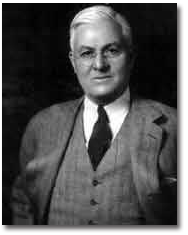George Crile
 The famous physician who was one of the founders of the famous Cleveland Clinic, worked for nine years formulating the all but forgotten bipolar theory of living processes. The works he did on the body's bioelectrical energies were truly monumental as was his work on the cause of surgical shock. He established the technique and value of the blood transfusion. During his long search for the underlying causes of fatigue, exhaustion and death at work in the University College of London, war hospitals in France, and the Western Reserve University Medical School, his data made it apparent that in order to understand the cause of surgical shock and death, it was necessary to understand the body as an electric potential. That is, the maintenance of the acid medium of the nucleus and the alkaline medium of the cytoplasm. His histological findings concluded that the lipoid films surrounding the nucleus and the cytoplasm offered a definite resistance to the positive hydrogen ions and that in death this resistance is lowered.
Crile believed that "the animal organism" as a whole is enmeshed in a network of highly specialized electric conductors - namely, the nervous system. In its physical composition, therefore, the body is not only highly adapted to electrical properties but its constituents in their interrelations within the organism could not be of any conceivable value in a mechanism operated by other forms of energy... We may consider then that electricity keeps the "flame of life" burning in the cell; and that the flame (oxidation) supplies the electricity which is the "vital force" of the animal... We may therefore consider the cell as a bipolar mechanism, the nucleus being positive element, the cytoplasm the negative element. The oxidation in the nucleus appears to be on a higher scale than the oxidation of the cytoplasm; and therefore as the electric tension increases in the nucleus, the current breaks through; the potential in the nucleus falls and in consequence the current is interrupted. Since the potential is again immediately restored by oxidation, we conceive that the interrupted current passes continually from the positive nucleus to the negative cytoplasm and in consequence a charge is accumulated on the surface films. These films of infinite thinness and of high dielectric capacity are peculiarly adapted to the storage and adaptive discharge of electric energy... There is no more energy per mass in the living than in the non-living. In the living, energy is captured and stored and made to run the organism - in the non-living the same amount of energy exists, but is balanced; equalized; inert; non-living.
His works and perceptions were nothing short of genius. What he called the Quest in his book THE PHENOMENA OF LIFE, A RADIO ELECTRIC INTERPRETATION (1936) was to find the cause and correction of death by surgical shock. After ten years of experimentation his states: According to our findings, the maintenance of the acid-alkali balance between the nucleus and cytoplasm of the cells - the electric potential - is essential to life and furnishes the immediate driving energy of the living process itself. Its reduction to zero or equilibrium is death... In structure and function the unit cells which drive the organism must be adapted to generate and to release radiation and electricity... The mechanism by which oxidation within the protoplasm of the cell generates the electric charges that operate the cell and the organism we postulate is due to the short wave radiation generated and emitted by oxidation within the protoplasm.
|